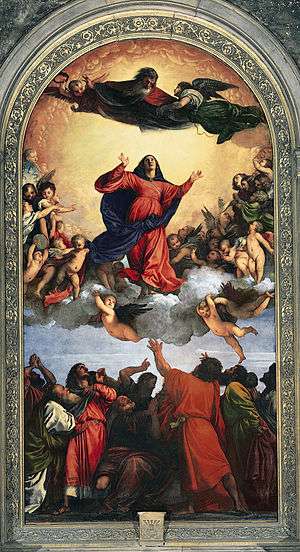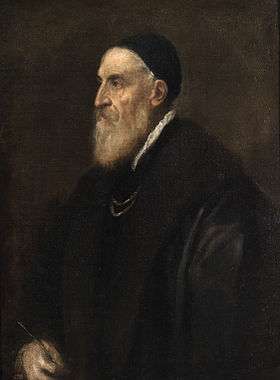Assumption of the Virgin (Titian)
 | |
| Artist | Titian |
|---|---|
| Year | 1516–18[1] |
| Medium | Oil on panel |
| Dimensions | 690 cm × 360 cm (270 in × 140 in) |
| Location | Basilica di Santa Maria Gloriosa dei Frari, Venice |
Assumption of the Virgin is a large oil painting by Italian Renaissance artist Titian, executed in 1516–18.[2] It is located on the high altar in the Basilica di Santa Maria Gloriosa dei Frari in Venice, being the largest altarpiece in the city.
History
The Assumption of the Virgin was Titian's first major commission in Venice. He soon became the lead painter of Venice. Breaking tradition with its heroic character scale and trademark color, its twisted Virgin and dramatically gesturing apostles disturbed passersby.[3] This panel was important in establishing Titian's popularity in Venice. According to some sources, an envoy to the emperor Charles V was present at the unveiling ceremony; he asked the Franciscans, who were doubtful about the painting's quality, to buy it lest they were tempted to remove it.[4]
When Titian placed this giant painting in its majestic marble frame, it garnered much attention. It was deemed worth noting by the Venetian diarist, Marino Sanuto the Younger, who wrote, "May 20, 1518: Yesterday the panel painted by Titian for ... the Minorites was put up."[5]
In 1818, it was moved to the Accademia, returning to its original place at the Frari in 1919.[6] Viewing the painting while housed in the Accademia, the young Oscar Wilde remarked that The Assumption was "certainly the best picture in Italy."[7]
Title
The Assumption of the virgin depicted in the painting is celebrated every year on August 15 and is a defined dogma of the Catholic church. It commemorates the rising of Mary to heaven before the decay of her body. It is a sign of her passing into eternal life and thus, it is a holy day of obligation.[8] There is a distinction between the ascension of Jesus and the assumption of Mary. The ascension was the rising of Jesus under his own power, while the assumption means that someone else raised Mary to heaven. It is said that Jesus himself came and carried her up.[9]
Description
Titian may have trained as a mosaic artist, and it has been suggested the golden background is a homage to the tradition of Venetian mosaics.[6] Titian primarily used oil-ground paint, which was prepared by his assistants. No one has the exact recipe, but the basic ingredients included linseed oil and gum turpentine.[10] The heroic figures and size were a new idea when the Assumption was placed in the Basilica. With its big dimensions, Titian was able to showpiece his work from different standpoints. He knew that with the varying distances of viewpoints, the bigger the picture, the more the angles.[11]
 | |
|
|
This picture shows different events in three layers. In the lowest layer are the Apostles. They are shown in a variety of poses, ranging from gazing in awe, to kneeling and reaching for the skies. In the center, the Virgin Mary is drawn wrapped in a red robe and blue mantle. She is raised to the heavens by a swarm of cherubim while standing on a cloud. Above is an attempt to draw God, who watches over the earth with hair flying in the wind. Next to him, flies an angel with a crown for Mary.[5]
See also
Notes
- ↑ "La pittura" (in Italian). Basilica S. Maria Gloriosa dei Frari. Archived from the original on 28 December 2012. Retrieved 29 November 2012.
- ↑ "Date of Completion". Retrieved 2011-01-24.
- ↑ Metropolitan Museum of Art. "Background". Titian (ca. 1488–1576). Archived from the original on 14 January 2011. Retrieved 2011-01-24.
- ↑ Jaffé, David (October 11, 2004). Titian. London: National Gallery Company. p. 192. ISBN 1-85709-903-6.
- 1 2 Durant, Will (1953). The Renaissance: A History of Civilization in Italy from the Birth of Petrarch to the Death of Titian - 1204 to 1576. New York: Simon and Schuster. p. 778. ISBN 0-671-61600-5.
- 1 2 "Movement of Painting". Retrieved 2011-01-24.
- ↑ Holland, Merlin, ed. Oscar Wilde: A Life in Letters. Fourth Estate: London and New York (2010). (unpaginated) Letter to Lady Wilde, 24 June 1875.
- ↑ Richert, Scott P. "About the Assumption of Mary". About.com. Retrieved 2011-01-25.
- ↑ "Ascension vs. Assumption". Archived from the original on 10 January 2011. Retrieved 2011-01-25.
- ↑ "Oil Ground Painting". Amien Forums. Retrieved 2011-01-24.
- ↑ "Composition". Retrieved 2011-01-24.
- ↑ "Titian's Assumption of the Virgin, c. 1516-18". Smarthistory at Khan Academy. Retrieved March 12, 2013.
References
| Wikimedia Commons has media related to Assumption of the Virgin by Titian (Venice). |
- Durant, Will (1953). The Renaissance: A History of Civilization in Italy from the Birth of Petrarch to the Death of Titian - 1204 to 1576
- Jaffé, David (October 11, 2004). Titian.
